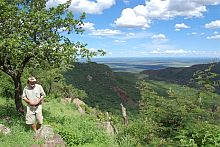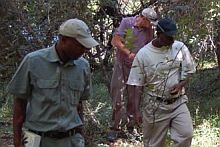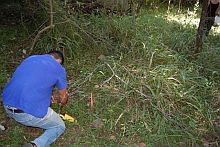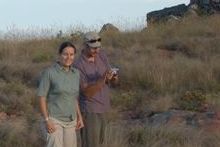SAEON Ndlovu Node working at altitude
|
Almost the entire SAEON Ndlovu Node staff had the opportunity to summit the highest peak of the Soutpansberg Mountains this May.
At a mere 1 740 metres, Lajuma is hardly a peak to brag about. Nevertheless, it is one of the highest points in the northern part of the country, and is high enough to harbour a range of unique plant and animal species. Together with strong gradients in climate, this makes it a prime location to study the effects of global climate change on biodiversity over the coming decades.
The Ndlovu Node has partnered with Lajuma Mountain Retreat, a private nature reserve owned by Ian Gaigher (previously of the University of Venda), to develop a climate change monitoring and research site in the Soutpansberg.
The reserve is already a focal point of ecological research, with an established research centre that attracts many overseas postgraduate students to study the various fauna of the area (including baboons, bushbuck and abundant leopard).
Recently, Dr Stefan Foord (University of Venda) set up an altitudinal transect of sites up (and down) the mountain to study the effects of climate on invertebrates (spiders and ants specifically), with funding from the Centre of Excellence for Invasion Biology (University of Stellenbosch).
Monitoring the vegetation
The SAEON Ndlovu Node plans to complement this research with monitoring of the vegetation along the same transect, as well as detailed studies of specialised plant species restricted to the peaks of the mountains. The latter are of particular interest, as changes in their distribution will serve as early indications of the effects of climate change in the northern part of South Africa.
A pilot study was conducted by Ndlovu Node staff to estimate the variation in plant species and tree density along the established transect. This will help in the design of a monitoring project, which will begin next summer.
The transect incorporates sites ranging from low-rainfall bushveld to thicket on the lower slopes, mistbelt forest on the upper slopes, and sourveld grassland on the peaks.














